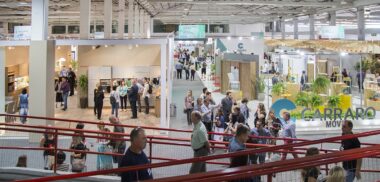Instituto Data Popular shows that the middle class spending on furniture totaled R$ 23 billion in 2013
Aiming to strengthen the focus on the new middle class, Movelsul Brasil, the largest furniture and accessory fair in Latin America, expects an increase in the purchasing power of its target audience. The forecast is that the 19th edition of the fair, held by the Furniture Industry Association of Bento Gonçalves (Sindmóveis), generates business worth US$ 300 million over a period of 12 months. Scheduled for March 24-28, 2014, the event takes place in Parque de Eventos in Bento Gonçalves.
In 2013, Brazilian spending on furniture totaled R$ 50 billion, almost half of it -R$ 23 billion – was made by the middle class. According to the Instituto Data Popular, the regions that most spent were the Southeast, accounting for R$ 23 billion, followed by the Northeast, R$ 10.3 billion. The northeastern and southeastern states also appear in the survey as those which intend to make more purchases over the next 12 months. The study also shows that 19 million middle class Brazilians wish to buy furniture this year.
Among those who have already bought furniture, 85% say they prefer larger stores. When choosing a product, 49% of the middle class takes into account the price and quality, and credit card and cash are the preferred method of payment. Income is directly related to the style of furniture that people most want. The lower the wage is, the greater is the preference for modern style. Based on this information, the Northern and Northeastern regions are the ones that most want to buy contemporary articles.
Movelsul Brasil has been focusing on the new middle class since its last edition in 2012. According to the president of Sindmóveis, Henrique Tecchio, manufacturing companies that have also bet on this new market are already seeing results. In 2013, manufacturers of low-end furniture were the fastest growing in the industry, while companies that make customized furniture struggled not to finish the year in the red. "The survey carried out by Instituto Data Popular serves as a source to exhibitors, providing information on the Brazilian preference for furniture. In March, the fair will showcase the trends of the stores for the year,” he says.
The Northeast is the region with the highest growth in the new middle class
In the last decade, 40 million Brazilians have joined the middle class, forming a stratum of over 100 million people. They consist of citizens who have climbed from poverty to be part of the consumption group brought about by social, political and economic transformations.
Currently, 54% of the population is part of the new middle class. Ten years ago, they accounted for 38%. During this time, the regions that most expanded their middle class were the Northeast (26%) and North (+19%), followed by the Midwest (+17%), South East (+10%) and South (+7%).
Customized furniture in neutral colors is the favorite
While colorful furniture is considered nicer, very successful décor among the middle class is one that involves light colors and modern furniture. White and other neutral colors are the favorites especially because they match with their homes.
The kitchen and the kids’ bedroom seem to be favorite spaces for the purchase of customized furniture. However, unable to pay for this type of furniture, the middle class family chooses modular furniture. In addition to fit into the living areas, modular units furnish spaces uniformly, similar to customized products.
Desire to remodel and decorate
Renovation and decoration play an important role in the idea of building a "home" for the new middle class. According to Data Popular, 55% of people plan to remodel their houses in the next 12 months. Of these, 31% want to change the decoration of their home.
Modernization is also a way of making the living space more enjoyable for neighbors and visitors. Therefore, there are recurrent investments in finishes and decoration items. Although people spend most of their time in their bedrooms, the living room is their priority when it comes to decoration. Among those interviewed by the institute, 43% said they would be investing in their living room, and 37% in their bedroom.



